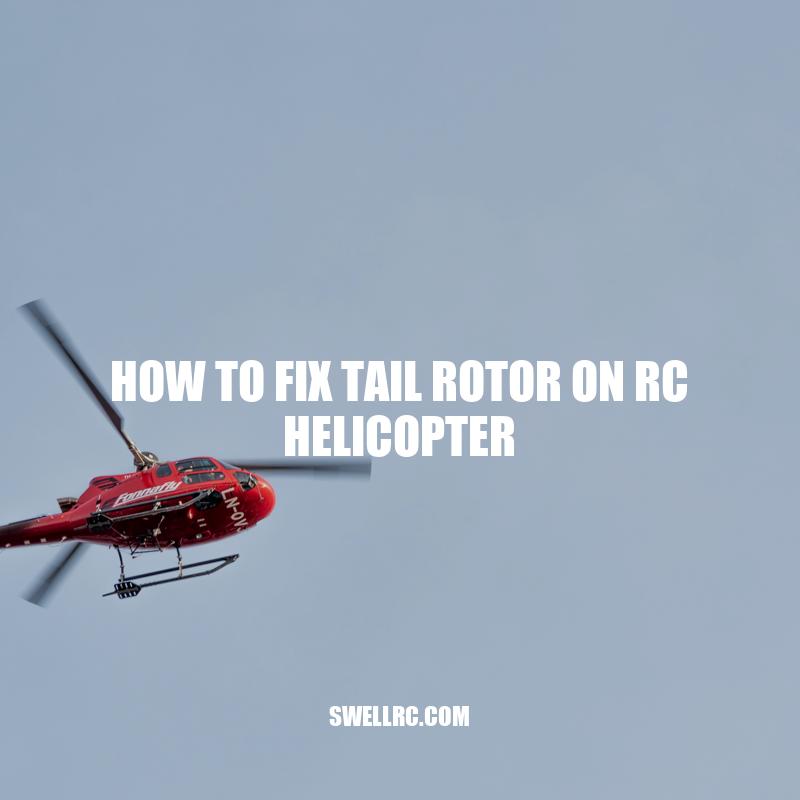How to Fix Tail Rotor on RC Helicopter: A Step-by-Step Guide
RC helicopters have been a popular hobby for enthusiasts for decades. Owning and operating an RC helicopter comes with its perks, but it also requires a certain level of responsibility. One of the most critical aspects of owning an RC helicopter is making sure that all its components are functioning correctly. One of these components is the tail rotor. A tail rotor plays a vital role in the operation of an RC helicopter. It helps to counteract the force of the main rotor blades, ensuring that the helicopter remains stable during flight. Hence, if there is a malfunction with the tail rotor, such as a broken linkage, it could result in a crash leading to severe damage to the helicopter. While it may seem daunting to fix the tail rotor, with some guidance and patience, it can be a manageable task. This article aims to provide readers with a step-by-step guide on how to fix a tail rotor on an RC helicopter. By following the steps below, readers will be able to diagnose and address the problem, replace damaged parts, and test the helicopter to ensure a smooth and safe flight.
Diagnosing the Problem
To fix a tail rotor on an RC helicopter, it is essential to understand the issue at hand. Diagnosing the problem can help in determining the necessary components and tools required for the repair. Here are some steps to help identify a malfunctioning tail rotor:
- Check if the helicopter spins uncontrollably in a fixed direction
- Listen for any grinding, squeaking, or screeching sounds from the tail rotor
- Inspect for visible damage, such as dents or bends, on tail rotor blades or the linkage
- Ensure that the gyroscopic sensor is located correctly and functioning correctly
There are other potential issues that could be causing the problem, such as a malfunction in the receiver or controller. Troubleshoot other components before determining that the tail rotor is the issue. If the tail rotor remains the issue, it’s essential to proceed with the necessary steps to repair it. Websites such as Amazon, eBay, and online hobby stores may have replacement parts for tail rotor fix, including rotor blades and linkages.
What to do if a helicopter tail rotor fails?
- Initiate autorotation immediately to maintain rotor rpm and gliding distance.
- Reduce airspeed and land as soon as possible in a safe area.
- Use open fields or clearings for emergency landings if possible.
- Inform air traffic control or other authorities of the situation and location.
If you want to learn more about helicopter safety and operations, visit the Federal Aviation Administration website at www.faa.gov. Additionally, you may want to check out the helicopter emergency egress devices available at www.helicopterescape.com.
Gathering Materials
After diagnosing the problem, the next step in fixing the tail rotor on an RC helicopter is to gather the necessary materials. Here’s a list of things you may need:
| Tools | Materials |
|---|---|
| Screwdrivers (small and medium-sized) | Tail rotor blade set |
| Needlenose pliers | Adhesive glue |
| Soldering iron | Safety googles |
| Solder | Cotton swabs |
| Heat gun | Extra tail rotor linkage |
Note that not all of the above tools and materials will be needed for every tail rotor issue. Double-check to ensure you have the correct size and blade pitch for your particular RC helicopter. You may also find some of the below websites useful for purchasing replacement parts and tools:
– Amain Hobbies
– Horizon Hobby
– Amazon
After gathering materials, proceed to disassemble the tail rotor assembly.
What controls the tail rotor on a helicopter?
The tail rotor on a helicopter is controlled by the tail rotor pedals, which are located in the cockpit. These pedals are used to change the pitch of the blades on the tail rotor, allowing the pilot to control the helicopter’s yaw or rotation around its vertical axis.
For more information on helicopters and aviation, check out websites and products such as Aviator Gear, Aviation Today, and Aviation Week.
Disassembly
Now that you have gathered the necessary tools and materials, it’s time to disassemble the tail rotor assembly. Here are the steps you should follow:
1. Disconnect the battery from the helicopter and ensure that no one can accidentally turn it on.
2. Remove the tail boom from the helicopter by unscrewing the screws that connect it to the chassis.
3. Remove the tail rotor blade set from the tail rotor hub by carefully unscrewing the screws.
4. Remove the tail rotor linkage from the servo arm by carefully disconnecting the ball link.
5. Now, remove the tail rotor hub from the tail boom. The hub will be secured to the boom with screws.
Be careful while disassembling the tail rotor, as the parts are delicate and fragile. Ensure that you organize the parts in a safe and clean place so that nothing goes missing. If you are unsure how to follow any of the above steps, refer to your RC helicopter’s manual or seek guidance from online forums and YouTube tutorials.
In the next paragraph, we will discuss how to repair the tail rotor.
What is the function of the tail rotor?
The tail rotor is a crucial component of a helicopter that helps to balance and control its movement. Its main functions are:
- Yaw control: The tail rotor counteracts the torque generated by the helicopter’s main rotor, which causes the body of the helicopter to spin in the opposite direction. By adjusting the pitch of the tail rotor blades, the pilot can control the yaw (horizontal) movement of the helicopter.
- Stability: The tail rotor also helps to stabilize the helicopter’s flight by controlling its sideways and forward/backward movements.
- Emergency landing: In case of a power failure, the tail rotor can help the pilot to make an emergency landing safely.
If you are interested in learning more about helicopters and their components, you can visit websites such as Helicopter Engineering or Helicopter Association International.
Repairing the Tail Rotor
After you’ve disassembled the tail rotor assembly, it’s time to repair the malfunctioning components. Here are the steps to repair the tail rotor:
1. Inspect the tail rotor blades for any damage. If they are damaged, replace them with new blades.
2. Inspect the tail rotor hub for any damage. If there are any cracks, replace it with a new one.
3. Inspect the tail rotor shaft for any bending. If it’s bent, replace it with a new one.
4. Inspect the bearings for any damage. If they are damaged, replace them with new ones.
5. If the tail rotor pitch slider is damaged, replace it with a new one.
6. If the tail rotor pitch control rod is bent, replace it with a new one.
7. Re-glue any loose or broken parts.
For any replacement parts, check with the manufacturer or hobby store to ensure you get the correct parts. When gluing components back together, ensure you use a fast-drying, strong adhesive. Follow the manufacturer’s instructions for the glue you are using.
In the next paragraph, we will discuss how to reassemble the tail rotor components.
What causes tail rotor failure?
Here are some common reasons for tail rotor failure:
- Structural damage from a previous accident or improper maintenance
- Manufacturing defects or material fatigue
- Failure of the tail rotor gearbox
- Damage to the tail rotor blades
- Piloting errors, such as excessive sideward or backward flight
If you’re interested in learning more about aircraft maintenance and safety, check out the Federal Aviation Administration’s website at www.faa.gov. If you’re a helicopter pilot or mechanic, you might also find useful resources and products at www.helicoptersonly.com.
Reassembly
Now that the tail rotor has been repaired, it’s time to start reassembling the components. Here’s how to do it:
1. Install the tail rotor blades onto the tail rotor hub. Ensure that each blade is installed in the correct position.
2. Install the tail rotor hub onto the tail rotor shaft. Ensure the hub rotates freely.
3. Install the tail rotor pitch slider onto the tail rotor hub.
4. Attach the tail rotor pitch control rod to the tail rotor pitch slider.
5. Reattach the tail rotor assembly back onto the helicopter tail boom. Ensure that you install it in the correct position.
6. Install the tail rotor servo back onto the helicopter. Reconnect all the wires and ensure that it’s securely in place.
Be sure to follow the manufacturer’s instructions for reassembly to ensure that you install everything correctly. Be cautious not to overtighten any screws or components as this can cause damage.
In the next paragraph, we will discuss how to safely test the helicopter to ensure the tail rotor is working correctly.
How are the rotor blades attached to the rotor disk?
Most helicopters have a main rotor consisting of two or more blades that are attached to the rotor hub or rotor disk by a series of bolts or retaining pins. The rotor hub itself is attached to the main rotor shaft, which is driven by the helicopter’s engine.
The way in which the rotor blades are attached to the rotor hub can vary depending on the helicopter model, but typically involves the following:
- The blade root is inserted into a receptacle in the rotor hub
- The blade is secured to the hub using a series of bolts or retaining pins
- The blade is attached to the rotor hub with a swashplate or other mechanical linkage, which allows the pilot to adjust the pitch of the blades in flight
For more information on helicopter components and systems, check out Helicopter HQ’s website or browse our selection of helicopter books and manuals.
Testing the Helicopter
Before you take your helicopter out for a full flight, it’s essential to test the tail rotor to ensure it’s repaired and working correctly. Here’s how to do it:
1. Turn on the transmitter and the helicopter.
2. Set the throttle to the lowest position.
3. Check that the tail rotor servo moves in the correct direction when you move the rudder stick on your transmitter.
4. Check that the tail rotor blades turn in the correct direction when the rudder stick is moved.
5. Take off and fly the helicopter in a safe and open area. Make small adjustments to the tail rotor pitch angle and the gyroscopic sensor as needed to get the helicopter to hover correctly.
It’s always a good idea to have a friend or fellow hobbyist with you during the testing phase to help you make any necessary adjustments.
Conclusion
Fixing a tail rotor on an RC helicopter can seem like a daunting task, but with the right tools, parts, and instructions, it’s a repair that most hobbyists can do on their own. It’s important to take your time, follow the manufacturer’s instructions and be cautious during disassembly and reassembly to avoid causing any further damage. Remember, if you’re unsure or uncomfortable with the repair, reach out to a professional for help. With patience and practice, you’ll be flying your repaired RC helicopter in no time.



